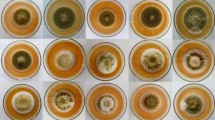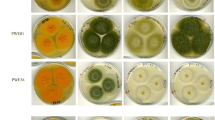Abstract
Pistachio is a popular snack food. Aflatoxin contamination of pistachio nuts is a serious problem for many producing countries. The development of biological control methods based on ecological parameters is an environmentally friendly approach. Thirty-eight Aspergillus flavus isolates collected from a pistachio orchard in California (CA) were analyzed for production of aflatoxin (AF), cyclopiazonic acid (CPA), vegetative compatibility groups (VCGs), and mating types. All aflatoxigenic isolates produced both AFB1 and CPA. The most toxigenic one was CA28 which produced 164 μg AFB1 per 5 ml PDA fungal culture and small sclerotia (S strain, sclertoium size less than 400 μm). The other aflatoxigenic strains produce AFB1 ranging from 1.2 μg to 80 μg per 5 ml fungal culture. Twenty-one percent of the CA isolates produced AFB1, 84% produced CPA and half formed sclerotia on at least one of three tested media. The 38 CA isolates formed 26 VCGs, 6 of which had two or more isolates and 20 contained single isolates. The S strain isolates belong to 4 different VCGs. Genomic profiling by a retrotransposon DNA probe revealed fingerprint patterns that were highly polymorphic. The predicted VCGs (Pred-VCGs) based on a similarity coefficient >80% matched the VCGs of multiple isolates determined by complementation. All isolates within a VCG had the same mating-type gene of either MAT1-1 or MAT1-2. Uncorrected and VCG-corrected MAT1-1 and MAT1-2 among the isolates were equally distributed.



Similar content being viewed by others
References
Abbas HK, Weaver MA, Zablotowicz RM, Horn BW, Shier WT (2005) Relationships between aflatoxin production and sclerotia formation among isolates of Aspergillus section Flavi from the Mississippi Delta. Eur J Plant Pathol 112:283–287
Amaikel S, Keller NP (2011) Aspergillus flavus. Annu Rev Phytopathol 49:107–133
Barros GG, Chiotta ML, Reynoso MM, Torres AM, Chulze SN (2007) Molecular characterization of Aspergillus section Flavi isolates collected from peanut fields in Argentina using AFLPs. J Appl Microbiol 103:900–909
Bayman P, Cotty PJ (1991) Vegetative compatibility and genetic diversity in the Aspergillus flavus population of a single field. Can J Bot 69:1707–1711
Cleveland TE, Dowd PF, Desjardins AE, Deepak B, Cotty PJ (2003) United States Department of Agriculture-Agricultural Research Service research on pre-harvest prevention of mycotoxins and mycotoxigenic fungi in US crops. Pest Manag Sci 59:629–642
Cotty PJ (1989) Virulence and cultural characteristics of two Aspergillus flavus strains pathogenic on cotton. Phytopathology 79:808
Cotty PJ (1997) Aflatoxin-producing potential of communities of Aspergillus section Flavi from cotton producing areas in the United States. Mycol Res 101:698–704
Cotty PJ, Cardwell KF (1999) Divergence of West African and North American communities of Aspergillus section Flavi. Appl Environ Microbiol 65:2264–2266
Cove DJ (1976) Cholorate toxicity in Aspergillus nidulans: the selection and characterisation of chlorate resistant mutants. Heredity 36:191–203
Doster MA, Michailides TJ (1994) Aspergillus molds and aflatoxins in pistachio nuts in California. Phytopathology 84:583–590
Ehrlich KC, Montalbano BG, Cotty PJ (2007) Analysis of single nucleotide polymorphisms in three genes shows evidence for genetic isolation of certain Aspergillus flavus vegetative compatibility groups. FEMS Microbiol Lett 268:231–236
European Commission 2006. The Rapid Alert System for Food and Feed (RASFF) Annual Report 2005. http://ec.europa.eu/food/food/rapidalert/report2005_en.pdf.
Grubisha LC, Cotty PJ (2010) Genetic isolation among sympatric vegetative compatibility groups of the aflatoxin–producing fungus Aspergillus flavus. Mol Ecol 19:269–280
Horn BW (2007) Biodiversity of Aspergillus section Flavi in the United States: a review. Food Addit Contam 24:1088–1101
Horn BW, Dorner JW (1998) Soil populations of Aspergillus species from section Flavi along a transect through peanut-growing regions of the United States. Mycologia 90:767–776
Horn BW, Dorner JW (1999) Regional differences in production of Aflatoxin B1 and cyclopiazonic acid by soil isolates of Aspergillus flavus along a transect within the United States. Appl Environ Microbiol 65:1444–1449
Horn BW, Greene RL (1995) Vegetative compatibility within populations of Aspergillus flavus, A. parasiticus, and A. tamarii from a peanut field. Mycologia 87:324–332
Horn BW, Moore GG, Carbone I (2009) Sexual reproduction in Aspergillus flavus. Mycologia 101:423–429
Hua S-ST, Tarun AS, Pandey SN, Chang L, Chang P-K (2007) Characterization of AFLAV, a Tf1/Sushi retrotransposon from Aspergillus flavus. Mycopathologia 163:97–104
Leslie JF (1993) Fungal vegetative compatibility. Annu Rev Phytopathol 31:127–150
McAlpin C, Mannarelli B (1995) Construction and characterization of a DNA probe for distinguishing strains of Aspergillus flavus. Appl Environ Microbiol 61:1068–1072
McAlpin CE, Horn BW, Wicklow DT (2005a) DNA fingerprinting analysis of vegetative compatibility groups in Aspergillus caelatus. Mycologia 97:70–76
McAlpin CE, Wicklow DT, Horn BW (2005b) DNA fingerprinting analysis of vegetative compatibility groups in in Aspergillus flavus from a peanut field in Georgia. Plant Dis 86:254–258
Papa KE (1986) Heterokaryon incompatibility in Aspergillus flavus. Mycologia 78:98–101
Payne GA et al (2006) Whole genome comparison of Aspergillus flavus and A. oryzae. Med Mycol 44:9–11
Peterson SW (2008) Phylogenetic analysis of Aspergillus species using DNA sequences from four loci. Mycologia 100:205–226
Pildain MB, Frisvad JC, Vaamonde G, Cabral D, Varga J, Samson RA (2008) Two novel aflatoxin-producing Aspergillus species from Argentinean peanuts. Int J Syst Evol Microbiol 58:725–735
Pitt JI, Hocking AD, Glenn DR (1983) An improved medium for the detection of Aspergillus flavus and A. parasiticus. J Appl Bacteriol 54:109–114
Ramirez-Prado JH, Moore GG, Horn BW, Carbone I (2008) Characterization and population analysis of the mating-type genes in Aspergillus flavus and Aspergillus parasiticus. Fungal Genet Biol 45:1292–1299
Razzaghi-Abyaneh M, Shams-Ghahfarokhi M, Allameh A, Kazeroon-Shiri A, Ranjbar-Bahadori S, Mirzahoseini H, Rezaee M-B (2006) A survey on distribution of Aspergillus section Flavi in corn field soils in Iran: population patterns based on aflatoxins, cyclopiazonic acid and sclerotia production. Mycopathologia 161:183–192
Rohlf FJ (1997) NTSYS-pc numerical taxonomy and multivariate analysis system. Exeter Software, Setauket, NY
Saito M, Tsuruta O (1993) A new variety of Aspergillus flavus from tropical soil in Thailand and its aflatoxin productivity. Proc Jap Assoc Mycotoxicol 37:31–36
Shearer JF, Sweets LE, Baker NK, Tiffany LH (1992) A study of Aspergillus flavus/Aspergillus parasiticus in Iowa crop fields: 1988–1990. Plant Dis 76:19–22
Turgeon BG, Yoder OC (2000) Proposed nomenclature for mating type genes of filamentous ascomycetes. Fungal Genet Biol 31:1–5
Vaamonde G, Patriarca A, Fernández Pinto V, Comerio R, Degrossi C (2003) Variability of aflatoxin and cyclopiazonic acid production by Aspergillus section flavi from different substrates in Argentina. Int J Food Microbiol 88:79–84
van Egmond HP, Schothorst RC, Jonker MA (2007) Regulations relating to mycotoxins in food perspective in a global and European context. Anal Bioanal Chem 389:147–157
Wicklow DT, McAlpin CE, Platis CE (1998) Characterization of the Aspergillus flavus population within an Illinois maize field. Mycol Res 102:263–268
Acknowledgments
This work is supported by in-house research program funds from U.S. Department of Agriculture, Agricultural Research Services. We thank K. Ehrlich, T. McKeon, X. He for comments; C.E. Platis, S. Hong, L.T. Fang, S. Kwong, E. Scharfenstein, Bertram Lee and L. Scharfenstein for technical assistance.
Conflict of interest
The authors declare that there are no conflicts of interest.
Author information
Authors and Affiliations
Corresponding author
Rights and permissions
About this article
Cite this article
Hua, S.S.T., McAlpin, C.E., Chang, PK. et al. Characterization of aflatoxigenic and non-aflatoxigenic Aspergillus flavus isolates from pistachio. Mycotoxin Res 28, 67–75 (2012). https://doi.org/10.1007/s12550-011-0117-4
Received:
Revised:
Accepted:
Published:
Issue Date:
DOI: https://doi.org/10.1007/s12550-011-0117-4




